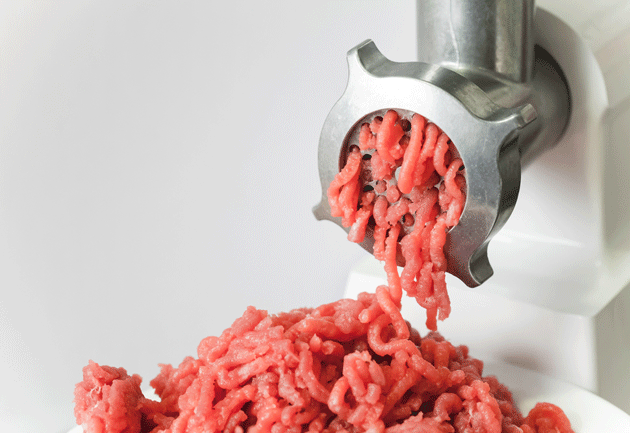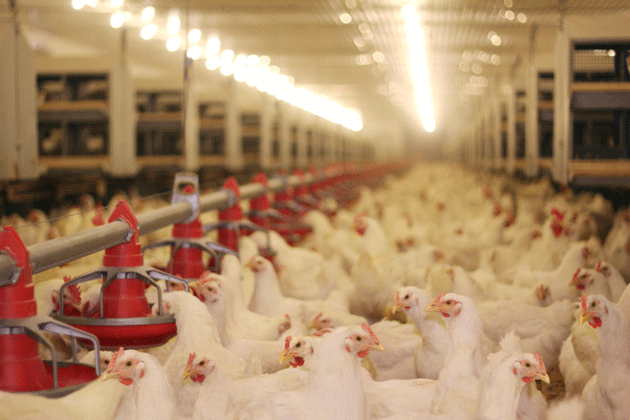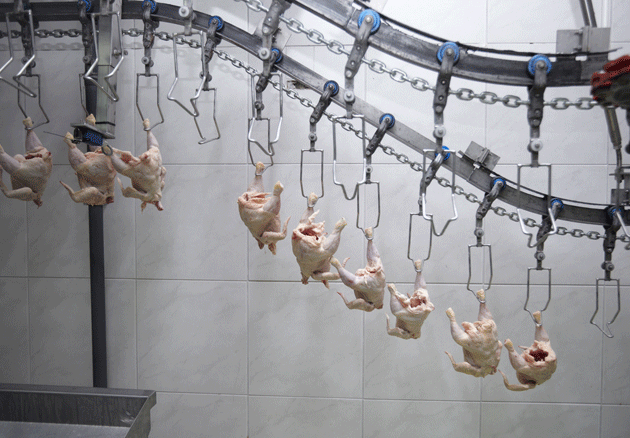
Eugene Sergeev/Shutterstock<a href="http://www.shutterstock.com/pic-126268430/stock-photo-mincer-machine-with-fresh-chopped-meat.html?src=G7sOJ9I-ov1KWEfwpR-EXw-1-15" target="_blank">Eugene Sergeev</a>/Shutterstock
The food-politics beat took a carnivorous turn in 2013. It’s not that all the year’s biggest stories involved the meat industry, but most seemed to. Here they are, in no particular order.
We’re emerging as the globe’s factory farm.
First, Virginia-headquartered pork giant Smithfield Foods announced it was phasing out ractopamine, a growth-enhancing, stress-inducing drug banned in China, the European Union, and Russia. Then it shocked the world by announcing it had been bought out by Shuanghui International, a Chinese conglomerate. And then several huge beef processors announced they were dropping Zilmax, a ractopamine-like growth enhancer for cows, also banned in big foreign markets. Meanwhile, China’s expanding industrial footprint is rapidly degrading its farmland even as its appetite for meat continues to grow. What do all these data points have in common? They signal a US meat industry increasingly looking to foreign markets for growth as America’s meat appetite wanes. And that means that even as we eat less meat, American communities will have to deal with the consequences of ever-intensifying meat production: water pollution, hollowed-out local economies, “egregious” food safety violations, deplorable working conditions, and an ongoing explosive manure foam problem.
The USDA really, really wants to speed up poultry slaughterhouse kill lines while reducing its inspection responsibilities.
Shaking off fierce opposition from food safety and worker advocates and a scathing report from the Government Accountability Office, the Obama administration tenaciously clung to long-brewing plans to cut inspectors on poultry kill lines while simultaneously allowing those lines to speed up, a move that would save the poultry industry a cool quarter billion dollars per year. The gory details are here and here. Meanwhile, the Obama administration isn’t alone in its eagerness for the change—this week, a bipartisan group of 13 US senators, mostly from chicken-heavy states like Arkansas, Missouri, and North Carolina, signed a letter to the USDA urging finalization of the speedup.
The FDA took tentative but important steps to curtail antibiotic abuse on meat farms. Finally. Sort of.
Way back in 1977, the Food and Drug Administration acknowledged the obvious: When you stuff animals together by the thousands and give them low daily doses of antibiotics, their bacteria will evolve to resist those drugs. Thirty-six years later—just this month—the administration finally did something about it. Kind of. True, most of the new rules curtailing antibiotics are voluntary. But as I noted, it rolled out a new proposal that would force meat producers to get a veterinarian’s approval before treating animals with antibiotics that are commonly used to treat human infections—a potentially (depending on how it’s enforced) significant reform.
Fast-food workers push back against low wages.
One major way Americans access the meat industry’s product is through fast-food chains, those $200 billion a year emporia of burgers, chicken nuggets, and the like. The industry profit model hinges on selling high volumes of cheap food while clamping down on costs, including labor. The nation’s 2.9 million fast-food workers make a median wage of $8.69 an hour, a level that has risen by (literally) just a dime in real terms since 1999. Contrary to the industry’s reputation as a benign source of mad money for moonlighting high schoolers, 70 percent of fast-food workers are 20 and older, and more than a third are 25 and older. Adults can’t support themselves, much less their families, on such stingy wages, so taxpayer-funded safety nets pick up the industry’s slack—to the tune of $7 billion per year, according to a 2013 University of California-Berkeley study. And 2013 marked year two of a high profile pushback, coordinated by the Service Employees International Union (SEIU), and punctuated by a series of one-day walkouts. Maybe slaughterhouse workers—who make a median hourly wage of $12.03 in one of the nation’s most hazardous jobs—will be next?
Europe says “no” to bee-harming neonicotinoid pesticides.
What do pesticides have to do with meat? Well, US livestock farms rely heavily on abundant corn and soy crops for feed, and those crops in turn are largely grown from seeds treated with a class of pesticides called neonicotinoids. A growing weight of science links widespread neonicotinoid use with the declining health of honeybees and other pollinators—and birds, too. In response, the European Union issued a two-year moratorium on the use of the chemicals, enraging their makers, European agrichemical giants Bayer and Syngenta. The US Environmental Protection Agency, for its part, has no plans of changing its laissez-faire position on neonics.

















